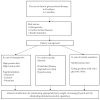The Role of Nutrition in the Pathogenesis and Treatment of Autoimmune Bullous Diseases-A Narrative Review
- PMID: 39599747
- PMCID: PMC11597059
- DOI: 10.3390/nu16223961
The Role of Nutrition in the Pathogenesis and Treatment of Autoimmune Bullous Diseases-A Narrative Review
Abstract
Autoimmune bullous diseases (AIBDs) are a group of conditions marked by the formation of blisters and erosions on the skin and mucous membranes. It occurs in all age groups, slightly more often affecting women. Several factors may be linked to the development of AIBDs, with nutrition being one of them. The literature mentions various food products and food ingredients acting as disease modifiers. Given the complex relationship between bullous diseases and nutrition, the current literature on AIBDs has been reviewed, with an emphasis on the influence of dietary modifications, various diets, and the nutritional consequences of these conditions. This review summarizes the role of nutrition in the pathogenesis and treatment of the following AIBDs: (i) pemphigus, (ii) bullous pemphigoid and mucous membrane pemphigoid, (iii) dermatitis herpetiformis, and (iv) epidermolysis bullosa acquisita. Several nutrients and dietary factors have been studied for their potential roles in triggering or exacerbating AIBDs. The key nutrients and their potential impacts include thiols and bulb vegetables (Allium), phenols, tannic acid, tannins, phycocyanin, isothiocyanates, all trans-retinoic acids, cinnamic acid, and walnut antigens. Many patients with ABIDs may require supplementation, particularly of vitamin D and B3, calcium, potassium, zinc, selenium, and cobalt. In addition, various diets play an important role. A soft diet is recommended for individuals with issues in the oral cavity and/or esophagus, particularly for those who experience difficulties with biting or swallowing. This approach is commonly used in managing pemphigus. A high-protein, high-calcium diet, DASH (Dietary Approaches to Stop Hypertension), and the Mediterranean diet are utilized during long-term glucocorticoid therapy. However, in dermatitis herpetiformis it is advisable to follow a gluten-free diet and eliminate iodine from the diet. When it comes to herbal supplements, Algae (Spirulina platensis), Echinacea, and St. John's wort (Hyperitum perforatum) enhance the ABIDs, while Cassia fistula may be recommended in the treatment of erosions in pemphigus vulgaris. Fast foods enhance the development of ABIDs. However, the pathomechanism is not yet fully understood. Future researchers should more precisely define the relationships between nutrients and nutrition and blistering diseases by also looking at, i.e., genetic predispositions, microbiome differences, or exposure to stress.
Keywords: autoimmune bullous diseases; dermatitis herpetiformis; diet; epidermolysis bullosa acquisita; nutrition; pemphigoid; pemphigus.
Conflict of interest statement
The authors declare no conflict of interest.
Figures
References
Publication types
MeSH terms
LinkOut - more resources
Full Text Sources
Medical


